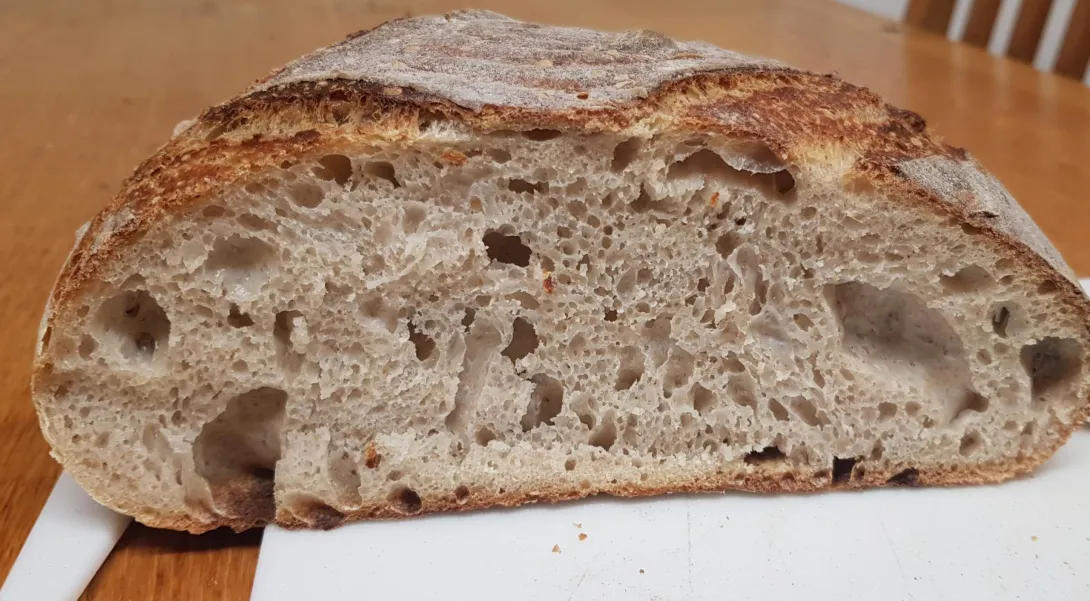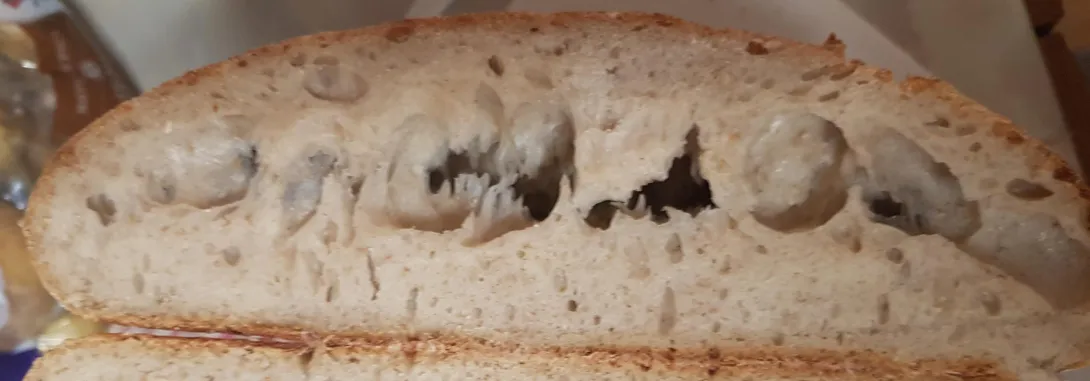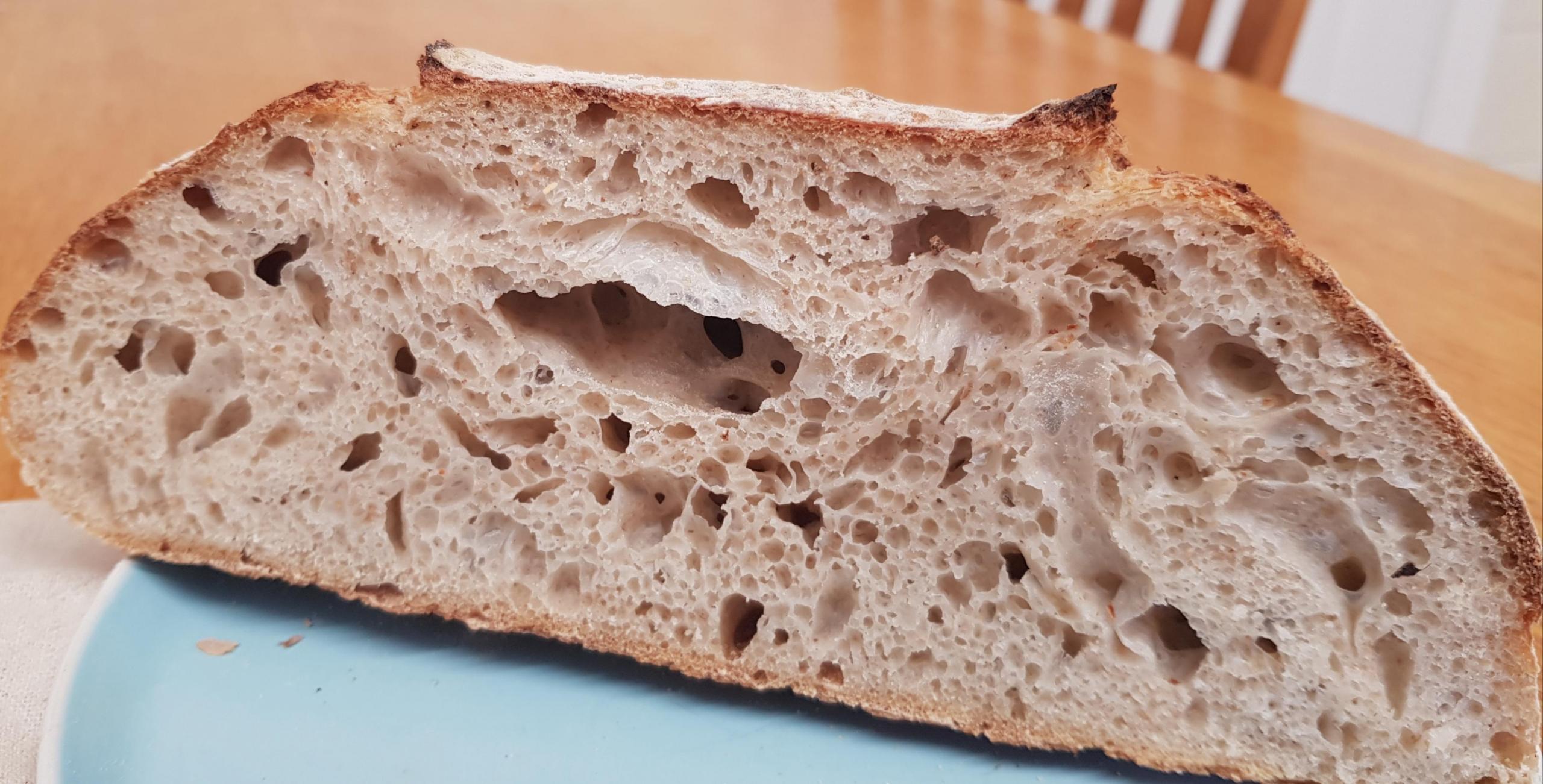Hi all,
Wondering if anyone can help but I'm getting large air bubbles at the surface (seam side) of my sourdough when proving at room temp before baking - these appear sometimes within minutes of sticking it in the banneton.
I'm working off a tartine recipe but today had to be a bit more flexible due to other commitments. It goes as follows:
450g strong white flour, 50g wholemeal and 350ml water to autolyse for approx 20mins
Add in 100g starter (approx 1:3:3, has doubled within 4 hours of feeding) and mix in, then add further 17g water with 10g salt.
I mixed it all together and today knew I couldn't attend to it so for the first few hours so I kneaded in the bowl for like 8 minutes or so. The dough temp was 25.4°c at the start of bulk.
I did a stretch and fold and some coil folds at 2, 4 and 6 hours bulk, with the dough temp remaining at the 25°c mark. It had risen by at least 30%, was bubbly on the surface and had clear bubbles on the sides and bottoms of the container.
I turned it onto the counter to preshape and it was airy albeit a little sticky. After 20 mins rest I did another preshape as felt it wasnt as strong as a previous loaf I did yesterday.
After another 20 min rest I flipped it over and shaped into a boule, there was a good amount of tension and small air bubbles were coming to the surface (smooth side) of the boule. I flipped it over and put into the banneton and within 20 minutes perhaps sooner, larger air bubbles seemed to accumulate on the top (seam side) of the boule, which became progressively worse. After 40 mins or so I decided to turn it out onto baking paper and put it in a dutch oven, i think had I not been quick with the transfer it would've become a total pancake.
I dont quite understand where I've gone wrong here. I did a sourdough yesterday with almost exactly the same recipe, though the temp of the dough was consistently at 27°c for the bulk and not 25°c like today, but the bulk today was about an hour longer and the end point felt compatible to yesterdays. I did retard yesterdays loaf (though my fridge was at 9°c so not great, and to be fair it did also have some bubbles but I guess being cold helped it keep its shape when turning out.
It's annoying as I see on YouTube people turn out their doughs from the banneton and they have wonderful structure and hardly seem to deflate at all, and I wonder just what I'm doing so incorrectly. For further context yesterday I was able to attend to the dough a bit more, and did regular stretch and folds at half and hour intervals (but didnt do any kneading in the bowl prior to bulk).
Any help would be appreciated. It's very frustrating. I feel for the first time I'm actually not under fermenting during bulk but who knows, perhaps I should just keep pushing with the bulk. It just seems that when I compare methods to ones i see on instagram, and in the tartine book, a decent bulk should take around 4 hours or so with the temperatures I'm at currently. My starter is fed usually twice a day at 6 and 6 and never goes in the fridge. I've made a fair amount of similar hydration non sourdough loaves so I dont think my shaping is so awful as to warrant what I think is a total lack of structure. Feels like the dough was overproved the minute I put it into the banneton.
Help!
6 hours bulk at 25C is a long bulk. Probably only need ~3 hours. 75% hydration with a long bulk, it's likely over proofed and your gluten is breaking down. Do you have a photo of the crumb? an after that you still have another hour for preshape to final shape and final proof. Did you have strong window pane after last fold?
Try doing your bulks 30 mins apart instead of 2 hours and after hour 3rd fold, give it an hour or until the dough expands an additional ~ 25- 30%. optional cold retard for up to 16 hours.
-James
Hi James,
Thanks for your advice. Normally I've massively struggled in the bulk and the dough has been very underdeveloped so the resulting bread is a mess. This one turned out surprisingly ok, do you think the crumb screams overproved too? What would indicate it (I am quite new to all this). Yesterdays loaf had a similar bulk and it was warmer though the crumb appeared better - I think you're right about the fridge. Next time I will try to keep as many variable the same and try and cut the bulk a little shorter to see what happens. The best thing about sourdough it that it's always a delicious mistake hah!
Thanks,
Anthony
Image

If it helps this is yesterdays loaf next to the one the day before, which had a (slightly) shorter and warmer bulk with more stretch and folds (and also bubbles after retarded final proof) can see where the crumb has more organisation but I think the second one had better spring to be fair!
Image

If you cannot attend to the dough, sometimes, the best thing to do is just to stick it in the fridge. you can do that at almost any point in time. just don't keep putting it in and taking it out. as for the stretch and folds... do a windows pane test after each set of folds. if you can get a good window pane, then it's ready to rest (build gas pockets) and go into shaping. you basically want your dough to relax enough for you to do the next set of folds which is typically 30 mins at those warm temperatures. you want to get the glutens developed as soon as possible, so that your bulk time is used to produce gas pockets in the dough. if you wait too long between sets before gluten is developed, the gas bubbles produced will burst easily. Also, handle the later folds and shaping delicately if you want a nice open crumb.
Good luck and report back!
James
Thanks James,
As for not being able to attend the dough that's why I did the kneading for about 8 minutes or so, to get the gluten a bit more developed. And as for the window pane test would you get false negatives if you did it after stretch and folds, where the gluten might be tighter and thus tear more easily? What did you think of the crumb?
Thank you,
Anthony
Most bakers will do a window pane immediately after each stretch and fold or coil fold to assess the gluten formation and whether or not the dough needs another s&f or coil fold to further develop gluten. Do it gently and it should be accurate.
I’ve been baking sourdough just over a year and I’ve always had trouble assessing rise and fermentation. I recently started using an aliquot jar and I’m now finding that I can gauge fermentation better. With each bake if I think the crumb showed signs of either relative under or over fermentation I can go further in either direction more easily because I know the degree of rise I had for that bake from the aliquot jar. Read about the aliquot jar here.
Benny
I'll echo what Benny said regarding window pane test after each stretch and fold. You're only doing a few folds each set, you're not trying to extend the dough to the limit and risk breaking any gluten strands. You don't need to push the stretching to the limit with those. So there shouldnt be any false negatives from that.
Regarding the crumb on your taller loaf. i think i do see some consistent expansion through out, but i think it should be quite a bit more open. Is it soft or does it feel dense?
James
Ah okay I see, thank you!!
The one of the right ironically felt heavier in the hand post bake than the lower loaf on the left. Both taste nice. I think I'll look into getting a separate jar to put a piece of the loaf in to better monitor bulk. Perhaps I was so afraid of under fermenting the bulk from previous attempts over the years i am now pushing it too long. Also having looked at the full proof baking resources I may look into doing more of a coil fold as opposed to stretch and folds. I mean my first loaves had a huge tunnel under the crust and just gummy everywhere so I'm pleased with the progress, it's just so frustrating, when after spending upwards of 8 hours with a dough, to end up with something not perfect ahah. Any other pearls of wisdom for me???
Thank you,
Anthony
I’m not sure if I have many pearls of wisdom with respect to baking, but don’t give up. One of the worst bakes I’ve ever had with sourdough I’ve just had recently. Just make sure you learn from each bake. As many bakers have said, we learn more from our failures than from our successes. I’ve certainly felt that to be true.
Also, make sure you keep copious notes, that way you can refer back to remember things that happened in a bake and what you did then compared to now, that is one way you will learn.
I wonder how you have determined that Most bakers do a window pane after S&F? That is not what I have observed
You are absolutely correct. Very poor choice of words on my part. I should instead say that many bakers use the window pane test after stretch and fold to determine gluten development. Apologies.
I wasn't criticizing, but looking for some clarification. If really most everyone did that but I had just never encountered them - that would be something interesting to have found out. Thanks for the clarification. I would agree more with the idea that some do at some point after the stretch and fold, but not after each one. Not saying that is correct, just what I have observed over the years.
I certainly know a lot of bakers who do windowpane after most of their stretch and folds. It is certainly a good way of keeping an eye on gluten development and deciding when is enough. Perhaps they don’t do a windowpane after the first set, but after the 2nd/3rd/4th many bakers do. Otherwise it can be hard to know when you’ve done enough gluten development.
Hi guys,
So following advice I tried another loaf today and it turned out much worse
Starter fed 1:2:2 for levain
Doubled at 4 hours
90% white
10% wholemeal
20% starter
2% salt
73% hydration
2 hour autolyse
Added starter and mixed for 4 mins
Rested 30mins
Added salt and mixed further 4 mins
Bulk ~ 3.5 hours at 25°c (average dough temp throughout no big changes)
Stretch and fold at half an hour
Coil folds x 3 at 45 min intervals
Pre shaped and rested 15 mins
Shaped and proved for 40mins at 22°c
Scored
Baked dutch oven 250°c 25mins lid on 20 mins kid off
Unfortunately the finished loaf is awful. I found with the autolyse and coil folds the bulk moved quite nicely, there were bubbles and there was a window pane. It had definitely risen by at least 30%. Pre shaping was good you could feel the dough nice and light. Felt full of air and I tried to be gentle. After shaping I only proved for 40mins in the garage at 22°c as I felt the bubbles were about to hit the surface of the dough in the banneton. The poke test seemed about right but the bake and crumb is ghastly.
I admit the temp was slightly lower and the bulk shorter so maybe I've under fermented where before I over fermented?
Image

Still tastes good but not really a functional bread, maybe for bread and butter pudding or croutons ahha.
Any advice here would be great.
Thanks,
Anthony
How are you doing your pre-shape and final shape?
I preshape with a bench scraper and scoop the dough across the kitchen surface to get the tension. It doesnt pancake much after 20mins or so, its edges are domed and not runny etc. Final shape I dust the top and flip it over and use the tartine method where you basically pull out the edges and fold into centre. I then flip it back over and do another couple of twists with the bench scraper
Anthony
I was guessing along those lines... i think the gluten is well developed on the outside of your loaf. but the inside is not as strong. try doing a letter fold (1/3 over from left, 1/3 over from right) then roll it up top to bottom gently to not deflate. for both your preshape and final shape. i know this is more for batard, but it does help putting some of the well formed gluten on the inside of the loaf.you can tighten the skin more with scraper after to round it out.
the way you are doing it should be working too. but i think some structural issue in the middle for whatever reason. so why not try this to give it more structure with a different shaping.
Thank you for the excellent advice! I will try it and post my progress. I think also doing same day sourdough is not helping, as I think a cold retard would help with slowing things down
Hi guys
Following your advice I think I've made a decent improvement! Definitely the different shaping method helped as well as trying lamination early on before coil folds. Dough about 74% hydration bulked for 4 hours at 26 degrees average, coil folds every 30mins. I used a coil fold then bench scraper to preshape and then final shape as per your advice. Only about 20mins at room temp before a 10 hour fridge retard. Temp was around 2 degrees and part of the banneton must have been on something much colder since part of the dough appeared almost frozen. I let it rest in the banneton on the counter for about an hour before tipping out, scoring and baking in a dutch oven. Flavour was nice but I think I could've retarded for longer, that being said there were still some bubbles on the seam side of the dough in the banneton! Going to keep going and soon try the aliquot idea!
Thanks all,
Anthony
Big improvement Anthony, good work. Had you used the aliquot jar, you would have been able to say, “well this result was after a X% rise and I want to push bulk fermentation further”. Then you could say next time I’ll try a (X+10)% rise and then compare the finished crumb. This is how I’ve been trying to fine tune my baking and it really works.
Yes I can see how feedback like that would be really helpful and it's something I will do in the next few attempts, just so relieved to bang out a decent loaf of bread hah. I think there are still some large pockets which might be shaping errors, perhaps too delicate, but delighted overall! Want to try a batard soon as it's a bit more conducive for toast!
Thank you!